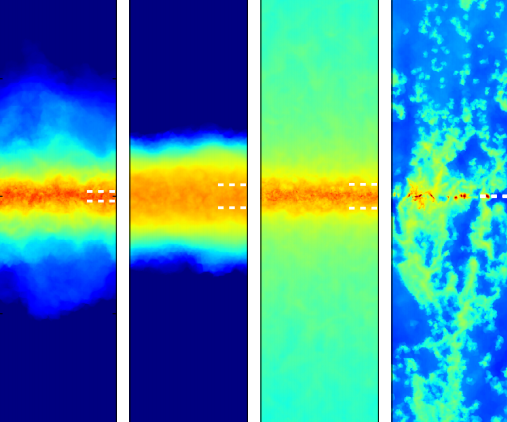Galactic outflows

We have studied formation of galactic outflows from supernova explosions (SNe) with the moving-mesh code AREPO in a stratified column of gas with a surface density similar to the Milky Way disk at the solar circle. The movie shows a comparison of different simulation models for SNe placement and energy feedback, including cosmic rays (CR). We find that models that place SNe in dense gas and account for CR diffusion are able to drive outflows with similar mass loading as obtained from a random placement of SNe with no CRs. Despite this similarity, CR-driven outflows differ in several other key properties including their overall clumpiness and velocity. Moreover, the forces driving these outflows originate in different sources of pressure, with the CR diffusion model relying on non-thermal pressure gradients to create an outflow driven by internal pressure and the random-placement model depending on kinetic pressure gradients to propel a ballistic outflow.
Credit for the visualizations below should be given to Christine M. Simpson and the publication:
- The role of cosmic ray pressure in accelerating galactic outflows
Simpson C. M., Pakmor R., Marinacci F., Pfrommer C., Springel V. (2016)
Astrophysical Journal Letters, X, X [ADS]
This movie compares the formation of galactic outflows in four different simulation models. Each column shows the projected gas density (see Figure 1 of Simpson et al. 2016 for further details). From left to right, the models shown are one without cosmic rays (NOCR), one with cosmic ray advection (CRAV), one with anisotropic cosmic ray diffusion (CRAD), and one without cosmic rays but with a random placement of supernovae (RAND).

Download:
high quality, MPEG4, 4.3 MB, 1000×994
About HITS
HITS, the Heidelberg Institute for Theoretical Studies, was established in 2010 by physicist and SAP co-founder Klaus Tschira (1940-2015) and the Klaus Tschira Foundation as a private, non-profit research institute. HITS conducts basic research in the natural, mathematical, and computer sciences. Major research directions include complex simulations across scales, making sense of data, and enabling science via computational research. Application areas range from molecular biology to astrophysics. An essential characteristic of the Institute is interdisciplinarity, implemented in numerous cross-group and cross-disciplinary projects. The base funding of HITS is provided by the Klaus Tschira Foundation.